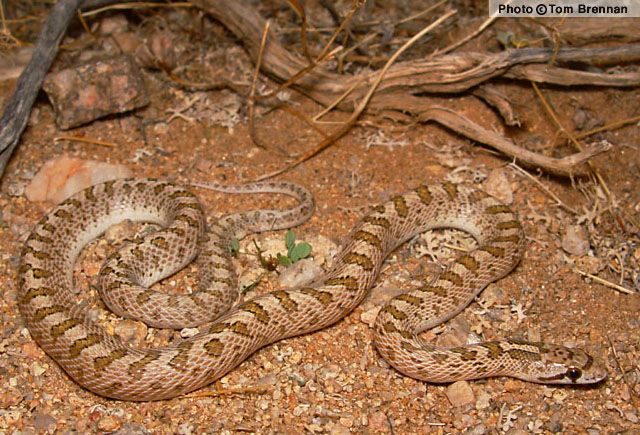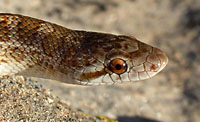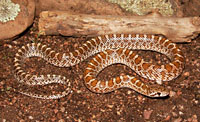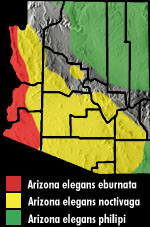Online Field Guide to The Reptiles and Amphibians of Arizona



Mohave County, AZ
 Apache Co., AZ |
| GLOSSY SNAKE Arizona elegans |
Non-Venomous
|
| DESCRIPTION: A medium-sized (up to 1,055 mm or 42″ in total length) snake with numerous dark-edged, tan, golden brown, or olive-gray blotches on a tan, light cream, pinkish, or gray background. Specimens from far western Arizona often have faded or washed-out looking pattern. The belly is plain pale gray. The pupils are round. This snake’s smooth and shiny scales distinguishing it from the similar looking Gophersnake which has keeled dorsal scales. The similar looking Nightsnake has vertically elliptical pupils.
DISTRIBUTION: In Arizona this snake is found across the northeastern plateaus, the southwestern and western deserts, and the southeastern valleys. It occurs at elevations ranging from near sea level along the Colorado River to about 6,000′. HABITAT: It inhabits biotic communities ranging from Arizona’s desertscrubs, through Semidesert Grassland, and into Plains and Great Basin Grassland. It is usually found in relatively flat, open, shrubby areas with sandy or loamy soil.BEHAVIOR: This nocturnal ground-dweller is good burrower that spends the majority of its time underground. It hibernates in an underground burrow during the cold months of winter and late fall. When threatened or harassed it often vibrates its tail. It rarely bites when captured.DIET: The Glossy Snake is a constrictor that feeds on small mammals, lizards, snakes, and birds.REPRODUCTION: Mating takes place in spring and a clutch of up to 23 eggs is laid in summer. Hatchlings begin to appear in August. SUBSPECIES FOUND IN AZ: ARIZONA GLOSSY SNAKE Arizona elegans noctivaga. This subspecies is found across most of south-central Arizona. It has a shorter tail relative to body size than the Painted Desert Glossy Snake. PAINTED DESERT GLOSSY SNAKE Arizona elegans philipi. This subspecies is found in the plateau region of northeastern Arizona and in the far southeastern corner of the state. It has a longer tail relative to body size than the other subspecies found in Arizona. By Thomas C. Brennan Bartlett. 2000. Snakes of North America: Western Brennan, T. C., and A. T. Holycross. 2006. A Field Guide to Amphibians and Reptiles in Arizona. Arizona Game and Fish Department. Phoenix, AZ Brennan, T. C., and A. T. Holycross. 2005. A Field Guide to Amphibians and Reptiles of Maricopa County. Arizona Game and Fish Department. Phoenix, AZ Degenhardt, W. G., Painter, C. W., and Price, A. H.. 1996. Amphibians and Reptiles of New Mexico. University of New Mexico Press. Albuquerque. Fowlie. 1965. The Snakes of Arizona. Azul Quinta Press, Fallbrook, California Stebbins. 1985. Western Reptiles and Amphibians. Houghton Mifflin. New York, |
|
Visit Partners in Amphibian and Reptile Conservation:


HOME
Copyright © 2023, Arizona Game and Fish Department. All rights reserved.
If you make use of the textual contents of this site in reports, publications, etc. please cite and credit the author(s) and photographer(s). All photos on this website are copyrighted. However, those found in the species account section may be used for any noncommercial scientific, educational, or conservation purposes provided that photographs are not altered and continue to bear the copyright symbol and name of the photographer. Please contact the photographer regarding commercial use of copyrighted photographs.











